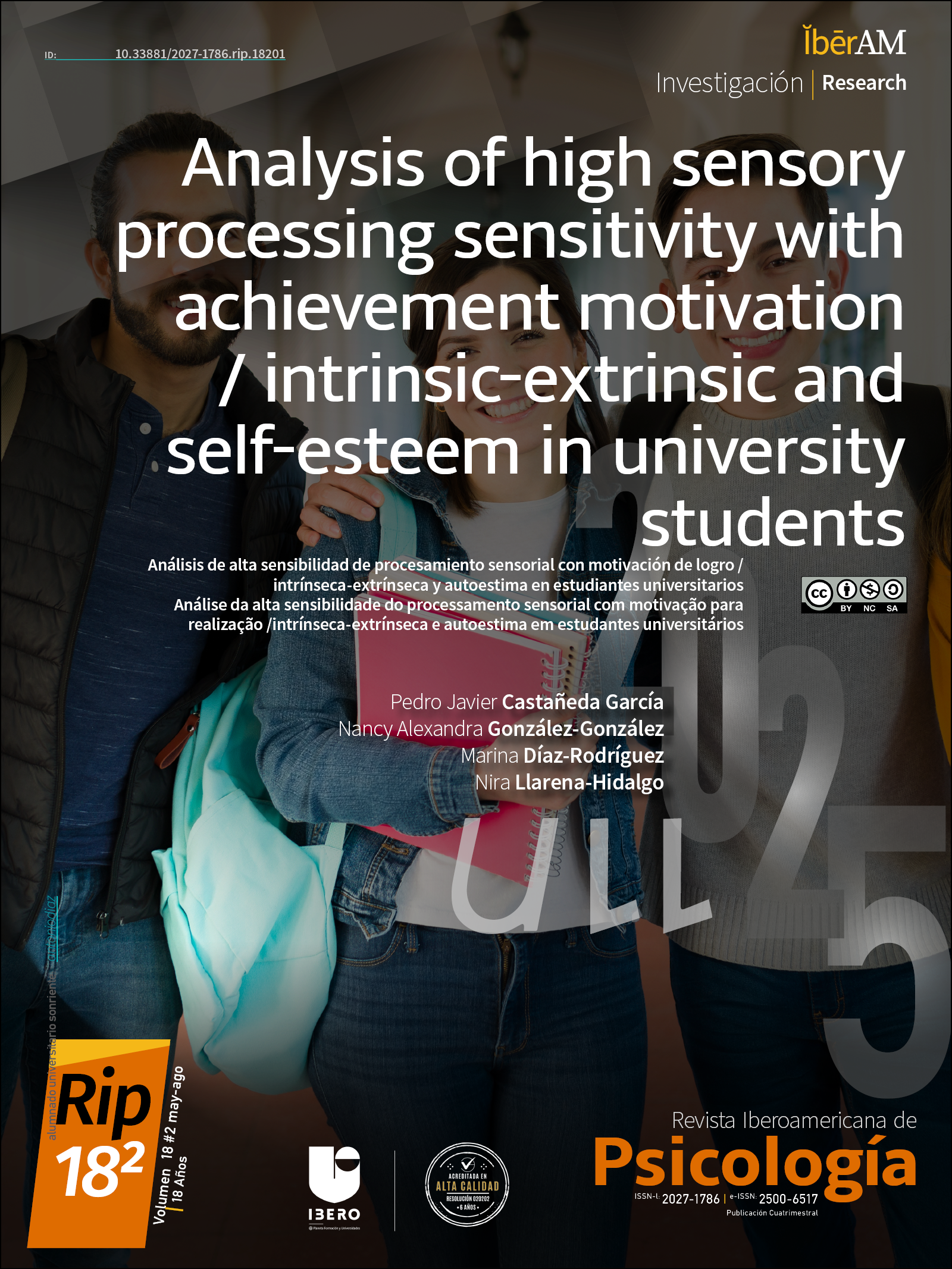Analysis of sensory processing sensitivity (SPS) with achievement motivation/intrinsic-extrinsic (AM/IAM-EAM) and self-esteem (S-E) in university students
Analysis of sensory processing sensitivity (SPS) with achievement motivation/intrinsic-extrinsic (AM/IAM-EAM) and self-esteem (S-E) in university students
Main Article Content
Background and aim: There is growing scientific interest in knowing more about highly sensitivity persons (HSP) within the new personality trait called sensory processing sensitivity (SPS). The aim of this work is to analyze that trait, in relation to general achievement motivation (AM) and AM divided into intrinsic-extrinsic (IAM-EAM), and self-esteem (S-E), as well as their relationship with sociodemographic variables. Method: 158 university students (Mage = 20.61; SD = 4.179; women 75.9%) answered three scales: HSPS-S (Chacón et al., 2021), CLAMS/IAM-EAM (Cassidy & Lynn, 1989; Story et al.., 2009) and RSES (Martín-Albo et al., 2007). Student's t-test, ANOVAS, correlations, and mediation analysis were applied. Results: They showed a medium level profile in SPS and AM, and a medium-high level in S-E; in addition, a negative correlation between HSP and S-E, and another positive one between AM and S-E were found. The higher the family income, the higher the S-E and in HSP, the higher AM without grant. EAM and its dimensions of acquisitiveness, competitiveness and status aspiration were greater in HSP. IAM and mastery, dominance and status aspiration were greater when S-E was high. S-E was lower in HSP, and this, in turn, resulted in a lower IAM and EAM. Conclusions: This group of students shows how S-E is a key mediating variable in HSP, as well as AM/IAM-EAM, and its multidisciplinary study should be expanded, given its influence on well-being and quality of life and, furthermore, it should be analyzed in childhood, adolescence, middle age and old age.
Downloads
Publication Facts
Reviewer profiles N/A
Author statements
- Academic society
- Bogotá: Corporación Universitaria Iberoamericana
- Publisher
- Bogotá: Corporación Universitaria Iberoamericana
Article Details
Acevedo, B. P., Aron, E. N., Aron, A., Sangster, M.-D., Collins, N., & Brown, L. L. (2014). The highly sensitive brain: An fMRI study of sensory processing sensitivity and response to others’ emotions. Brain and Behavior, 4, 580–594. http://doi.org/6h3
Acosta-García, J., Checa y Olmos, F., Lucas-Matheu, M., & Parrón-Carreño, T. (2019). Self-esteem levels vs global scores on the Rosenberg self-esteem scale. Heliyon, 5(3), 1-17. https://doi.org/10.1016/j.heliyon.2019.e01378
Aguilar-Durán, L. A. (2020). Perfeccionismo y vida académica: un estudio correlacional en estudiantes de psicología [Perfectionism and academic life: A correlational study in psychology students]. Revista Iberoamericana de Psicología, 13(2), 87–98. https://doi.org/10.33881/2027-1786.rip.13209
Andresen, M., Goldmann, P., & Volodina, A. (2018). Do overwhelmed expatriates intend to leave? The effects of sensory processing sensitivity, stress, and social capital on expatriates' turnover intention. European Management Review, 15(3), 315-328. https://doi.org/10.1111/emre.12120
Angarita-Becerra, L. D. (2014). Algunas relaciones entre la procrastinación y los procesos básicos de motivación y memoria [Some relationships between procrastination and the basic processes of motivation and memory]. Revista Iberoamericana de Psicología, 7(1), 91–102. https://doi.org/10.33881/2027-1786.rip.7108
Aron, E. N. (2004). Revisiting Jung’s concept of innate sensitiveness. Journal of Analytical Psychology, 49(3), 337-367. https://doi.org/10.1111/j.1465-5922.2004.00465.x
Aron. E. N. (2010). The Undervalued Self. Little Spark Brown.
Aron, E. N. (2011). Psychotherapy and the highly sensitive person: Improving outcomes for that minority of people who are the majority of clients. Routledge.
Aron, E. N. (2020). Clinical assessment of sensory processing sensitivity. In B. P. Acevedo (Ed.), The highly sensitive brain: Research, assessment, and treatment of sensory processing sensitivity (pp. 135–164). Elsevier Academic Press. https://doi.org/10.1016/B978-0-12-818251-2.00006-0
Aron, E. N., & Aron, A. (1997). Sensory processing sensitivity and its relation to introversion and emotionality. Journal of Personality and Social Psychology, 73(2), 345-368. https://doi.org/10.1037/0022-3514.73.2.345
Aron, E. N., Aron, A., & Jagiellowicz, J. (2012). Sensory processing sensitivity: A review in the light of the evolution of biological responsivity. Personality and Social Psychology Review: An Official Journal of the Society for Personality and Social Psychology, Inc, 16(3), 262–282. https://doi.org/10.1177/1088868311434213
Atkinson, J. W. (1964). An introduction to motivation. Van Nostrand.
Auza-Montalvo, F. J. (2018). Perfeccionismo y motivación en estudiantes de la carrera de Psicología de una universidad privada [Perfectionism and motivation in Psychology major students at a private university]. [Tesis título profesional, Universidad Marcelino Champagnat. Perú]. Repositorio Institucional UMCH. https://hdl.handle.net/20.500.14231/562
Ávila, M., & Cañas-Lucendo, M. (2023). Niveles de satisfacción con la vida y su relación con la autoestima en adolescentes [Levels of satisfaction with life and its relationship with self-esteem in adolescents]. Psicología UNEMI, 7(12), 23-34. https://doi.org/10.29076/issn.2602-8379vol7iss12.2023pp23-34p
Balluerka, N., Aliri, J., Goñi-Balentziaga, O., & Gorostiaga, A. (2023). Asociación entre el bullying, la ansiedad y la depresión en la infancia y la adolescencia: el efecto mediador de la autoestima [Association between bullying, anxiety and depression in childhood and adolescence: the mediating effect of self-esteem]. Revista de Psicodidáctica, 28(1), 26–34. https://doi.org/10.1016/j.psicod.2022.10.001
Bhatt, S., & Bahadur, A. (2018). Role of Self Esteem & Self Efficacy in Achievement Motivation among College Students. The International Journal of Indian Psychology, 6(2), 5-13. https://doi.org/10.25215/0602.061
Barreto-Trujillo, F. J., & Álvarez-Bermúdez, J. (2020). Las dimensiones de la motivación de logro y su influencia en rendimiento académico de estudiantes de preparatoria [The dimensions of achievement motivation and their influence on academic performance of high school students]. Enseñanza e Investigación en Psicología, 2(1), 73-83. https://revistacneipne.org/index.php/cneip/article/view/66
Baryła-Matejczuk, M., Artymiak, M., Ferrer-Cascales, R., & Betancort, M. (2020). The Highly Sensitive Child as a challenge for education – introduction to the concept. Problemy Wczesnej Edukacji, 48(1), 51–62. https://doi.org/10.26881/pwe.2020.48.05
Baryła-Matejczuk, M., Bieniek, J., & Ślusarczyk, A. (2021). Link between sensory processing sensitivity and self-esteem using the example of a group of polish adolescents. Journal of Communication and Behavioural Science, 2(2), 5-18. https://www.ceeol.com/search/article-detail?id=1009605
Bas, S., Kaandorp, M., de Kleijn, Z. P. M., Braaksma, W. J. E., Bakx, A. W. E. A., & Greven, C. U. (2021). Experiences of Adults High in the Personality Trait Sensory Processing Sensitivity: A Qualitative Study. Journal of Clinical Medicine, 10(21), 1-17. https://doi.org/10.3390/jcm10214912
Cáceres-Ruíz, M., & Ponce-Delgado, R. (2023). Dependencia emocional y su relación con el riesgo suicida en adultos jóvenes [Emotional dependence and its relationship with suicide risk in young adults]. LATAM. Revista Latinoamericana de Ciencias Sociales y Humanidades, 4(1), 329-339. https://doi.org/10.56712/latam.v4i1.247
Cassidy, T., & Lynn, R. (1989). A multifactorial approach to achievement motivation: The development of a comprehensive measure. Journal of Occupational Psychology, 62(4), 301-312. https://doi.org/10.1111/j.2044-8325.1989.tb00001.x
Chacón, A., Pérez-Chacón, M., Borda-Mas, M., Avargues-Navarro, M. L., & López-Jiménez, A. M. (2021). Cross-Cultural Adaptation and Validation of the Highly Sensitive Person Scale to the Adult Spanish Population (HSPS-S). Psychology Research and Behavior Management, 14, 1041–1052. https://doi.org/10.2147/PRBM.S321277
Chávez-Parillo, J. R., & Peralta-Gómez, R. Y. (2019). Estrés académico y autoestima en estudiantes de enfermería, Arequipa-Perú [Academic stress and self-esteem in nursing students, Arequipa-Peru]. Revista de Ciencias Sociales, 25(1), 384-399. https://dialnet.unirioja.es/servlet/articulo?codigo=7113737
Challco-Huatyalla, K., Rodríguez-Vega, S., & Jaime-Soncco, J. (2016). Riesgo de adicción a redes sociales, autoestima y autocontrol en estudiantes de secundaria [Risk of addiction to social networks, self-esteem and self-control in high school students]. Revista Científica de Ciencias de la Salud, 9(1), 9-15. https://doi.org/10.17162/rccs.v9i1.542
Collantes, K. D., & Tobar, A. (2023). Adicción a redes sociales y su relación con la autoestima en estudiantes universitarios [Addiction to social networks and its relationship with self-esteem in university students]. LATAM. Revista Latinoamericana de Ciencias Sociales y Humanidades, 4(1), 848-860. https://doi.org/10.56712/latam.v4i1.300
Coopersmith, S. (1967). The antecedents of self-esteem. Freeman.
Costa-López, B., Ferrer-Cascales, R., Ruiz-Robledillo, N., Albaladejo-Blázquez, N., & Baryła-Matejczuk., M. (2021). Relationship between Sensory Processing and Quality of Life: A Systematic Review. Journal of Clinical Medicine, 10(17): 1-20. https://doi.org/10.3390/jcm10173961
De Gucht, V., & Woestenburg, D. H. A. (2024). Development and validation of the SPSQ-26: A short form of the Sensory Processing Sensitivity Questionnaire (SPSQ). European Journal of Psychological Assessment. Advance online publication. https://doi.org/10.1027/1015-5759/a000803
De Gucht, V., Woestenburg, D. H. A., & Wilderjans, T. F. (2022). The Different Faces of (High) Sensitivity, Toward a More Comprehensive Measurement Instrument. Development and Validation of the Sensory Processing Sensitivity Questionnaire (SPSQ). Journal of Personality Assessment, 104(6), 784–799. https://doi.org/10.1080/00223891.2022.2032101
Dong, J., Hassan, N. C., Hassan, A. B., Chen, D., & Guo, W. (2024). Effect of Achievement Motivation and Self-Efficacy on General Well-Being among Students at Normal Universities in Ningxia: The Mediating Role of Time Management. Behavioral Sciences, 14(1), 1-12. https://doi.org/10.3390/bs14010015
Eccles, J. S., & Wigfield, A. (2020). From expectancy-value theory to situated expectancy-value theory: A developmental, social cognitive, and sociocultural perspective on motivation. Contemporary Educational Psychology, 61, 1-13. https://doi.org/10.1016/j.cedpsych.2020.101859
Erentaitė, R., Vosylis, R., Sevalneva, D., Melnikė, E., Raižienė, S., & Daukantaitė, D. (2022). Profiles of Achievement Motivation and Performance in Middle School: Links to Student Background and Perceived Classroom Climate. Frontiers in Psychology, 13, 1-16. https://doi.org/10.3389/fpsyg.2022.820247
Facchini, M., Triventi, M., & Vergolini, L. (2021). Do grants improve the outcomes of university students in a challenging context? Evidence from a matching approach. Higher Education, 81(5), 917–934. https://doi.org/10.1007/s10734-020-00586-3
Fernández-Angulo, O. (2020). Autoestima y motivación del logro en estudiantes de secundaria de una institución educativa. La Esperanza, 2017 [Self-esteem and achievement motivation in high school students of an educational institution. La Esperanza, 2017] [Tesis título profesional, Universidad Católica Los Ángeles Chimbote. Perú]. Repositorio Institucional ULADECH. https://repositorio.uladech.edu.pe/handle/20.500.13032/16615
González-Martínez, M. T. (1999). Algo sobre la autoestima. Qué es y cómo se expresa [Something about self-esteem. What it is and how it is expressed]. Aula, 11, 1-16. https://revistas.usal.es/tres/index.php/0214-3402/article/view/3530/3550
Greven, C. U., Lionetti, F., Booth, C., Aron, E. N., Fox, E., Schendan, H. E., Pluess, M., Bruining, H., Acevedo, B., Bijttebier, P., & Homberg, J. (2019). Sensory processing sensitivity in the context of environmental sensitivity: A critical review and development of research agenda. Neuroscience and Biobehavioral Reviews, 98, 287–305. https://doi.org/10.1016/j.neubiorev.2019.01.009
Listou-Grimen, H., & Diseth, Å. (2016). Sensory Processing Sensitivity: Factors of the Highly Sensitive Person Scale and Their relationships to Personality and Subjective Health Complaints. Perceptual and Motor Skills, 123(3), 637–653. https://doi.org/10.1177/0031512516666114
Hayes, A. F. (2022). Introduction to mediation, moderation, and conditional process analysis: A regression-based approach. Guilford publications.
Helguera, G. P., & Oros, L. B. (2018). Perfeccionismo y autoestima en estudiantes universitarios argentinos [Perfectionism and self-esteem in Argentine university students]. Pensando Psicología, 14(23), 1-15. https://doi.org/10.16925/pe.v14i23.2266
Hidalgo-Fuentes, S., Martínez-Álvarez, I., & Sospedra-Baeza, M. J. (2022). Autoestima y procrastinación en el ámbito académico: un metaanálisis [Self-esteem and procrastination in the academic field: A meta-analysis]. Revista Fuentes, 24(1), 77-89. https://doi.org/10.12795/revistafuentes.2022.19907
Hofmann, S. G., & Bitran, S. (2007). Sensory-processing sensitivity in social anxiety disorder: Relationship to harm avoidance and diagnostic subtypes. Journal of Anxiety Disorders, 21(7), 944–954. https://doi.org/10.1016/j.janxdis.2006.12.003
Homola, S. Y., & Oros, L. B. (2023). Apego, autoestima y habilidades de autoexpresión social: un modelo de encadenamiento causal en jóvenes y adolescentes [Attachment, self-esteem and social self-expression skills: a causal chain model in young people and adolescents]. Actualidades en Psicología, 37(134), 85-98.
https://repositorio.uca.edu.ar/handle/123456789/18352
Jagiellowicz, J., Aron, A., & Aron, E.N. (2016). Relationship between the temperament trait of sensory processing sensitivity and emotional reactivity. Social Behavior and Personality: An International Journal, 44(2), 185-199. https://doi.org/10.2224/sbp.2016.44.2.185
Kibe, C., Suzuki, M., Hirano, M., & Boniwell, I. (2020). Sensory processing sensitivity and culturally modified resilience education: Differential susceptibility in Japanese adolescents. PLoS ONE, 15(9), 1-17. https://doi.org/10.1371/journal.pone.0239002
Konrad, S., & Herzberg, P. Y. (2017). Psychometric properties and validation of a german high sensitive person scale (HSPS-G). European Journal of Psychological Assessment, 35(3), 364–378. https://doi.org/10.1027/1015-5759/a000411
Kraus, M. W., & Park, J. W. (2014). The undervalued self: Social class and self-evaluation. Frontiers in Psychology, 5, 1-9. https://doi.org/10.3389/fpsyg.2014.01404
Lionetti, F., Arthur, A., Aron. E. N., Burns, L.,
Jagiellowicz, J., & Pluess, M. (2018). Dandelions, tulips and orchids: evidence for the existence of low-sensitive, medium-sensitive and high-sensitive individuals. Translational Psychiatry, 8(24), 138-52. https://doi.org/10.1038/s41398-017-0090-6
Malinakova, K., Novak, L., Trnka, R., & Tavel, P. (2021). Sensory Processing Sensitivity Questionnaire: A Psychometric Evaluation and Associations with Experiencing the COVID-19 Pandemic. International Journal of Environmental Research and Public Health, 18(24), 1-14. https://doi.org/10.3390/ijerph182412962
Martín-Albo, J., Núñez, J. L., Navarro, J. G., & Grijalvo, F. (2007). The Rosenberg Self-Esteem Scale: Translation and Validation in University Students. The Spanish Journal of Psychology, 10(2), 458-467. https://doi.org/10.1017/S1138741600006727
Mora-Grimón, A. I., Martín-Pinillos-Gallego, C., Cruz-Santana, V., & Castañeda-García, P. J. (2023). Análisis de afrontamiento, sensibilidad de procesamiento sensorial (SPS) y resiliencia en alumnado universitario, en el segundo año de la Covid-19 [Analysis of coping, sensory processing sensitivity (SPS) and resilience in university students, in the second year of Covid-19]. Revista Iberoamericana de Psicología, 16(2), 57–68. https://doi.org/10.33881/2027-1786.rip.16206
Morales-Rodríguez, M. (2023). Procrastinación en estudiantes universitarios: rol de la autoestima, creencias de autoeficacia y motivación de logro [Procrastination in college students: role of self-esteem, self-efficacy beliefs, and achievement motivation]. RECIE. Revista Electrónica Científica de Investigación Educativa, 7, 1-13. https://doi.org/10.33010/recie.v6i0.1307
Naegeli, A. S. (2018). Vivir con alta sensibilidad: Entre el talento y la fragilidad [Living with high sensitivity: Between talent and fragility, 2016]. Herder Editorial.
Nocentini, A., Menesini, E., & Pluess, M. (2018). The Personality Trait of Environmental Sensitivity Predicts Children’s Positive Response to School-Based Antibullying Intervention. Clinical Psychological Science, 6(6), 848-859. https://doi.org/10.1177/2167702618782194
Orth, U. (2018). The family environment in early childhood has a long-term effect on self-esteem: A longitudinal study from birth to age 27 years. Journal of Personality and Social Psychology, 114(4), 637–655. https://doi.org/10.1037/pspp0000143
Pérez-Chacón, M., Borda-Mas, M., Chacón, A., & Avargues-Navarro, M. L. (2023). Personality traits and coping strategies as psychological factors associated with health-related quality of life in highly sensitive persons. International Journal Environment Research and Public Health, 20(9), 1-16. https://doi.org/10.3390/ijerph20095644
Pluess, M., Assary, E., Lionetti, F., Lester, K. J., Krapohl, E., Aron, E. N., & Aron, A. (2018). Environmental sensitivity in children: Development of the Highly Sensitive Child Scale and identification of sensitivity groups. Developmental Psychology, 54(1), 51–70. https://doi.org/10.1037/dev0000406
Rosas-Jiménez, C. A. (2020). Personas altamente sensibles. Psicologia em Estudo, 25, 1-3. https://doi.org/10.4025/psicolestud.v25i0.47811
Rosenberg, M. (2015). Society and the Adolescent Self-Image. Princeton University Press.
Ruíz-González, P., Medina-Mesa, Y., Zayas, A., & Gómez-Molinero, R. (2018). Relación entre la autoestima y la satisfacción con la vida en una muestra de estudiantes universitarios [Relationship between self-esteem and life satisfaction in a sample of university students]. Revista INFAD de Psicología. International Journal of Developmental and Educational Psychology, 2(1), 67-76. https://doi.org/10.17060/ijodaep.2018.n1.v2.1170
Salinas-Quintana, P. J., Barría-Ramírez, R., Acevedo, B. P., Vega-Muñoz, A., Pérez-Chacón, M., & Chacón, A. (2024). Cross-cultural adaptation and validation of the Spanish sensory processing sensitivity questionnaire (S-SPSQ). Frontiers in Psychology, 15, 1-16. https://doi.org/10.3389/fpsyg.2024.1279889
Samsen-Bronsveld, H. E., van der Ven, S. H., Bogaerts, S., Greven, C. U., & Bakx, A. W. (2022). Sensory processing sensitivity does not moderate the relationship between need satisfaction, motivation and behavioral engagement in primary school students. Personality and Individual Differences, 195, 1-8. https://doi.org/10.1016/j.paid.2022.111678
Silva-Escorcia, I., & Mejía-Pérez, O. (2015). Autoestima, adolescencia y pedagogía [Self-esteem, adolescence and pedagogy]. Revista Electrónica Educare, 19(1), 241-256. http://dx.doi.org/10.15359/ree.19-1.13
Sohst, K. (2017). El poder de la sensibilidad: Cómo identificar a las personas altamente sensibles y qué podemos aprender de ellas [The power of sensitivity: How to identify highly sensitive people and what we can learn from them, 2016]. Editorial Ariel.
Sotardi, V., & Dubien, D. (2019). Perfectionism, wellbeing, and university performance: A sample validation of the Frost Multidimensional Perfectionism Scale (FMPS) in New Zealand. Personality and Individual Differences, 143, 103-106. https://doi.org/10.1016/j.paid.2019.02.023
Stoeber, J. (2018). The psychology of perfectionism: An introduction. In J. Stoeber (Ed.), The psychology of perfectionism: Theory, research, applications (pp. 3–16). Routledge/Taylor & Francis Group. https://psycnet.apa.org/record/2017-21407-001
Story, P. A., Hart, J. W., Stasson, M. F., & Mahoney, J. M. (2009). Using a Two-Factor Theory of Achievement Motivation to Examine Performance-Based Outcomes and Self-Regulatory Processes. Personality and Individual Differences, 46, 391-395.
http://dx.doi.org/10.1016/j.paid.2008.10.023
Suraj, S., Kohle, S., Prakash, A., Tendolkar, V., & Gawande, U. (2024). Achievement Motivation Among Health Sciences and Engineering Students During COVID-19. Annals of Neurosciences, 31(1), 36–43. https://doi.org/10.1177/09727531231169628
Suraj, S., Lohi, R., Singh, B., & Patil, P. (2024). Self-esteem and Locus of Control as Predictors of Academic Achievement: A Study Among Graduate Students. Annals of Neurosciences. Published online August 24, 09727531231183214. https://doi.org/10.1177/09727531231183214












